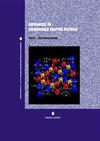(1−x) PbMg1/3Nb2/3O3-(x)K1/2Bi1/2TiO3陶瓷的电模量分析
IF 1.8
4区 物理与天体物理
Q3 PHYSICS, CONDENSED MATTER
引用次数: 0
摘要
铁电体是指具有自发极化特性的介电体群。采用固相反应路由技术制备了铌镁铅-钛酸铋钾((1−x) pbm1 / 3nb2 / 3o3 -(x)K1/2Bi1/2TiO3) x = 0.15、0.25和0.35。采用复阻抗谱法对制备的样品在400°C、450°C和500°C不同频率范围内的电模量进行了研究。在低频范围内,实模量(M′(ω))随温度的升高而减小。实模量(M′(ω))随掺杂频率和掺杂浓度的增加而增加。虚模量(M″(ω))随温度的升高而增大。实系数和虚系数的显著变化表明在所选组分之间存在热激活的介电弛豫。晶粒电容的大小随温度的升高而增大,证实了材料的电阻温度系数为负。本文章由计算机程序翻译,如有差异,请以英文原文为准。
Electric Modulus Analysis of (1 − x) PbMg1/3Nb2/3O3-(x)K1/2Bi1/2TiO3 Ceramics
Ferroelectrics refer to groups of dielectrics having the property of spontaneous polarization. Lead magnesium niobate-potassium bismuth titanate ((1 − x) PbMg1/3Nb2/3O3-(x)K1/2Bi1/2TiO3)) x = 0.15, 0.25, and 0.35 are prepared by solid-state reaction rout technique. The electric modulus of the prepared samples is studied using the complex impedance spectroscopic method at 400°C, 450°C, and 500°C in various frequency ranges. In the lower frequency range, the real modulus (M′ (ω)) decreased with increasing the temperature. Furthermore, the real modulus (M′ (ω)) increased with increasing frequency and the concentration of the doping component. The imaginary modulus (M″ (ω)) increased with increasing the temperature. The significant variations in the real and imaginary coefficients signify the existence of thermally activated dielectric relaxation between the selected components. Moreover, the magnitude of grain capacitance increased with increasing the temperature, confirming the negative temperature coefficient of resistance of the material.
求助全文
通过发布文献求助,成功后即可免费获取论文全文。
去求助
来源期刊

Advances in Condensed Matter Physics
PHYSICS, CONDENSED MATTER-
CiteScore
2.30
自引率
0.00%
发文量
33
审稿时长
6-12 weeks
期刊介绍:
Advances in Condensed Matter Physics publishes articles on the experimental and theoretical study of the physics of materials in solid, liquid, amorphous, and exotic states. Papers consider the quantum, classical, and statistical mechanics of materials; their structure, dynamics, and phase transitions; and their magnetic, electronic, thermal, and optical properties.
Submission of original research, and focused review articles, is welcomed from researchers from across the entire condensed matter physics community.
 求助内容:
求助内容: 应助结果提醒方式:
应助结果提醒方式:


